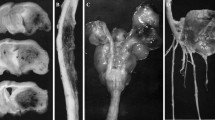Summary
Pildralazine, a hydralazinelike antihypertensive vasodilator containing a free hydrazine group, was administered in the drinking water to male and female B6C3F1 and to female BALB/c mice at 100, 200, and 400 ppm dose levels for 80 weeks. The animals were kept under observation until 130–133 weeks of age, when the experiment was terminated. A transplacentalinfantile bioassay was also carried out with pildralazine administered in the drinking water at 200 and 400 ppm dose levels to female C57BL/6J mice for 1 week before mating with C3Hf males and during mating and pregnancy. The progeny received the same doses for 10 weeks after birth and were kept under observation until 80–85 weeks of age, when the experiment was terminated. In both long-term and transplacental-infantile assays, control and treated groups developed the pattern of tumors usually observed in the strains used and no tumor type at any site appeared to be related to treatment.
Similar content being viewed by others
References
Becker FF (1982) Morphological classification of mouse liver tumors based on biological characteristics. Cancer Res 42:3918–3923
Bhide SV, Maru GB, Mate NB, Menon M, Gangadharan P (1981) Metabolic studies on the possible mode of action of isoniazid tumorigenicity. J Cancer Res Clin Oncol 99:153–166
Biancifiori C, Ribacchi R (1962) Pulmonary tumors in mice induced by oral isoniazid and its metabolites. Nature 194:488–489
Bigger CAH, Tomaszewski JE, Dipple A (1978) Differences between products of binding of 7,12-dimethylbenz(a)anthracene to DNA in mouse skin and in a rat liver microsomal system. Biochem Biophys Res Commun 80:229–235
Della Porta G, Capitano J, Parmi L, Colnaghi MI (1967) Urethan carcinogenesis in newborn, suckling, and adult mice of C57BL, C3H, BC3F1, C3Hf and SWR strains. Tumori 53:81–102
Della Porta G, Terracini B (1969) Chemical carcinogenesis in infant animals. Progr Exp Tumor Res 11:334–363
Dorigotti L, Rolandi R, Carpi C (1976) A new antihypertensive compound: 3 hydrazino-6-[(2-hydroxypropyl)methylamino] pyridazine dihydrochloride (ISF 2123). Pharmacol Res Commun 8:295–308
Dragani TA (1979) Analysis of tumor incidence in BALB/c mice used as controls in carcinogenicity experiments. Tumori 65:665–675
Frei JV, Lawley PD (1980) Thymomas induced by simple alkylating agents in C57BL/Cbi mice: kinetics of the dose response. J Natl Cancer Inst 64:845–856
Parodi S, De Flora S, Cavanna M, Pino A, Robbiano L, Bennicelli C, Brambilla G (1981) DNA-damaging activity in vivo and bacterial mutagenicity of sixteen hydrazine derivatives as related quantitatively to their carcinogenicity. Cancer Res 41:1469–1482
Pellegrini R, Abbondati G (1977) Characteristics and clinical effects of ISF 2123, a new antihypertensive agent. Farmaco [Prat] 32:19–24
Peto R, Pike MC, Armitage P, Breslow NE, Cox DR, Howard SV, Mantel N, McPherson K, Peto J, Smith PG (1977) Design and analysis of randomized clinical trials requiring prolonged observation of each patient. II. Analysis and examples. Br J Cancer 35:1–39
Peto R, Pike MC, Day NE, Gray RG, Lee PN, Parish S, Peto J, Richards S, Wahrendorf J (1980) Guidelines for simple, sensitive significance tests for carcinogenic effects in long-term animal experiments. In: IARC monographs on the evaluation of the carcinogenic risk of chemicals to humans. Lyon, France (Suppl. 2, Long-term and short-term screening assays for carcinogens: A critical appraisal, pp. 311–426)
Rogers KJ, Pegg AE (1977) Formation of O6-methylguanine by alkylation of rat liver, colon, and kidney DNA following administration of 1,2-dimethylhydrazine. Cancer Res 37:4082–4087
Simonotti L, Colombo R, Pifferi G (1979) Gas chromatographicmass spectrometric identification of urinary metabolites of propildazine in rat. In: Frigerio A (ed) Recent developments in mass spectrometry in biochemistry and medicine. Plenum, New York (Vol 2, pp. 27–41)
Terracini B, Testa MC (1970) Carcinogenicity of a single administration of N-nitrosomethylurea: a comparison between newborn and 5-week-old mice and rats. Br J Cancer 24:588–598
Toth B (1980) Actual new cancer-causing hydrazines, hydrazides, and hydrazones. J Cancer Res Clin Oncol 97:97–108
Trainin N, Precerutti A, Law LW (1964) Trends in carcinogenesis by urethan administration to new-born mice of different strains. Nature 202:305–306
Ventura P, Parravicini F, Simonotti L, Colombo R, Pifferi G (1981) Degradation of propildazine in water. J Pharm Sci 70:334–336
Vesselinovitch SD (1973) Comparative studies on perinatal carcinogenesis. In: Tomatis L, Mohr U (eds) Transplacental carcinogenesis. IARC Scientific Publications, Lyon, France (No 4, pp. 14–22)
Walters MA (1966) The induction of lung tumors by the injection of 9,10-dimethyl-1,2-benzanthracene (DMBA) into newborn, suckling and young adult mice. Br J Cancer 20:148–160
Ward JM, Goodman DG, Squire RA, Chu KC, Linhart MS (1979) Neoplastic and nonneoplastic lesions in aging (C57BL/6NxC3H/HeN)F1 (B6C3F1) mice. J Natl Cancer Inst 63:849–854
Author information
Authors and Affiliations
Additional information
This paper is dedicated to Prof. Cesare Biancifiori, who died in Perugia on January 6, 1983
Rights and permissions
About this article
Cite this article
Della Porta, G., Dragani, T.A. Carcinogenicity study in mice on pildralazine, a hydralazinelike antihypertensive compound. J Cancer Res Clin Oncol 106, 97–101 (1983). https://doi.org/10.1007/BF00395386
Received:
Accepted:
Issue Date:
DOI: https://doi.org/10.1007/BF00395386



